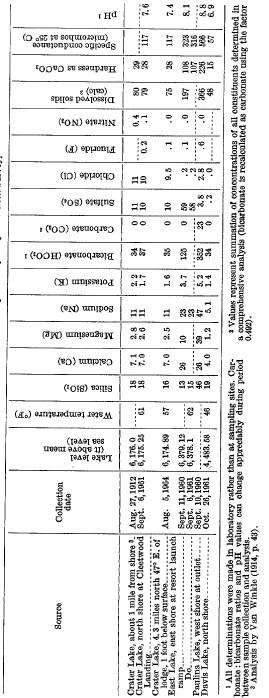Hydrology of Crater, East and Davis Lakes, Oregon by Kenneth N. Phillips
CHEMISTRY OF THE LAKES
By A. S. VAN DENBURGH
DAVIS LAKE
Davis Lake is fed by snowmelt runoff, direct precipitation, and spring flow, all presumably very dilute. The dilute nature of this inflow is mirrored by the chemical character of the lake. The dissolved solids concentration is only about 50 ppm, and the principal constituents are silica, calcium, sodium, and bicarbonate (table 13). These constituents are common to most dilute ground and surface water of mountainous regions where annual precipitation rates are high and evaporation rates are low.
The small dissolved-solids content of Davis Lake supports the hydraulic evidence that subsurface leakage is an important means of water loss. The average seepage of 150 cfs from Davis Lake and its dissolved-solids concentration of 48 ppm indicate an average annual loss of about 7,000 tons. The similarity between the dissolved-solids concentration of Davis Lake (as indicated by a specific conductance of 57 micromhos) and that of a spring (58 micromhos) 1.8 miles northnortheast of the lake and about 50 feet lower, suggests significant leakage by way of this spring and several others, which have combined discharge of 160 to 280 cfs.
| TABLE 13.-Chemical and physical character of the lakes |
 |
***previous*** — ***next***

